By Dr. Thomas M. Hemmerling, Department of Anesthesiology, McGill University Montreal, Quebec, Canada
Anesthesiologists may soon use a device that will help them automate the control of general anesthesia and monitor patients during surgical procedures. That’s because researchers at McGill University developed a closed-loop control system using National Instruments’ (NI) LabVIEW graphical programming software. Once approved by Health Canada and the US Food and Drug Administration, the device will automatically monitor a patient’s depth of consciousness, level of pain, and muscle relaxation to calculate and administer appropriate doses of anesthetic drugs.
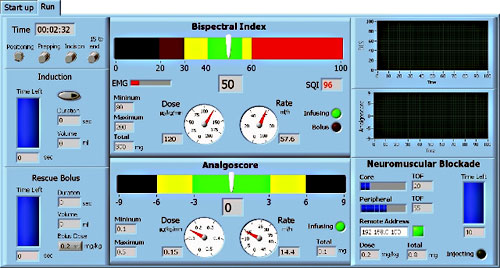
Graphical elements such as dials and color coding track a patient’s level of consciousness using a bispectral index.
When conducting a surgical procedure, doctors typically administer anesthetics to block all sensation for the patient including pain or distress. Based on the type of procedure, patients can receive a local, spinal, or general anesthetic. General anesthetics render the patient unconscious and in a state of paralysis during the surgery.
General anesthesia consists of drugs that produce three reactions: hypnosis to remove the patients’ consciousness and put them in a deep sleep, analgesia to block the conscious sense of pain, and relaxation to prevent unwanted muscle movement. Before surgeons begin their procedures, anesthesiologists choose the appropriate doses of the medications to achieve all three of these reactions. Throughout the surgery, anesthesiologists must manage the levels of medications they administer, which can consume more than 20% of their time.
To give anesthesiologists more time to manage other aspects of the surgery, our team of anesthesiologists and biomedical engineers developed a prototype for an automated anesthesia system. Called “McSleepy,” the goal of this system is to assist anesthesiologists, not replace them.
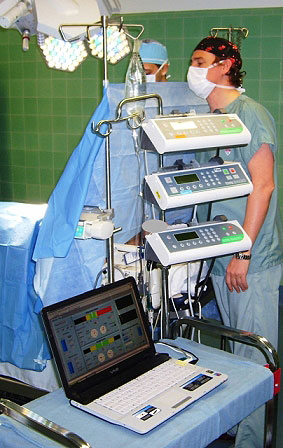
The McSleepy prototype is being tested in surgical settings.
To use McSleepy, anesthesiologists insert an IV and apply the sensors that measure muscle movement to the patient. They then input patient information including age, height, weight, sex, the type of surgery being performed, and any preferences the anesthesiologist has regarding the drug doses for the patient.
After the system begins to administer the drugs, McSleepy monitors and controls the drug doses every minute through a mathematical algorithm we developed using LabVIEW. The patient’s data are then displayed on a LabVIEW-based graphics user interface (GUI), so that the anesthesiologist can see how the patient responds to the anesthetics. By using LabVIEW to develop the GUI, we integrated familiar graphical elements such as dials that look like speedometers and thermometers and color coding to track the patient’s level of consciousness using a bispectral index. We also used our proprietary “Analgoscore” algorithm to track the patient’s level of pain.
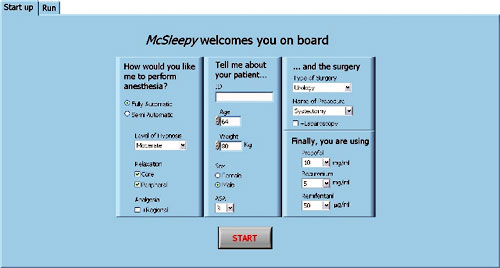
McGill researchers used LabVIEW to create a user-friendly GUI.
To avoid giving the patient too much or too little medication in the event that McSleepy does not function properly, we built multiple safety features into the system. First, anesthesiologists can manually override any aspect of the system. For example, if the computer stops receiving signals from one of the sensors, the machine automatically enters basic manual mode. Throughout the procedure, the machine calculates the average amount of anesthetics given to the patient during each 15-minute period. In the event that the system does not work properly, it can then administer the average amount of anesthetics to keep the patient asleep and pain-free until either the problem is resolved or the anesthesiologist begins to manually control the anesthesia.
Additionally, if anesthesiologists operate the system in semiautomatic mode so that they can manually input doses of medications, and they input something that does not seem right, such as accidentally entering too much of a certain drug, the machine warns the anesthesiologists that the dose is too high. The McSleepy program has built-in artificial intelligence. The machine can learn things such as the surgeon’s preferences and the length of the various procedures performed. After use on approximately 20 of the same surgeries with the same surgeon, McSleepy begins to recognize patterns. At the end of each surgery, McSleepy stores trend data. Overall, because the machine is a closed-loop control system that uses a combination of artificial intelligence and human input, McSleepy may actually be safer than having only an anesthesiologist administer the medications.
By developing a GUI with LabVIEW, we can address the common problem with most closed-loop control systems, which is that they lack a user interface so the user cannot see what is happening. Human interaction is very important to anesthesiologists. They can easily monitor the amount of anesthetics being administered and make changes if needed. In fact, at the Society for Technology in Anesthesia annual meeting in January 2009, fellow anesthesiologists awarded the McSleepy design team with the Excellence in Technology Innovation Award.
We upgraded to the LabVIEW 8.6 platform, which helps us deploy the McSleepy interface to personal digital assistants (PDAs). In doing so, anesthesiologists can perform remote control, monitoring, and recording of their patients. This capability is critical because many countries lack specialists such as anesthesiologists, and, in the future, anesthesiologists may need to take care of several patients at one time.
We currently have a fully functional prototype of the McSleepy system with off-the-shelf hardware and our proprietary algorithm. Using this prototype, we are developing a strategy to enter the market within five years. This plan includes securing funding to conduct more research tofurther enhance and commercialize our system, as well as seeking approval from both Health Canada and the U.S. Food and Drug Administration.
McGill University
www.mcgill.ca
::Design World::
Filed Under: ENGINEERING SOFTWARE, Medical-device manufacture



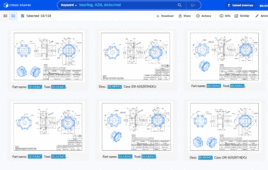
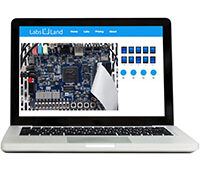
Tell Us What You Think!